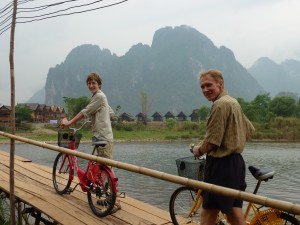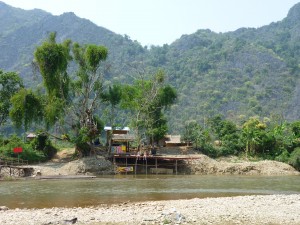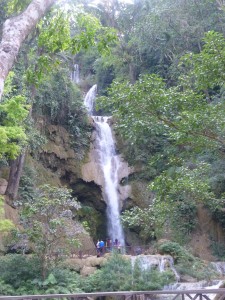The act of traveling to a country reminds me of one of the truths of quantum physics; the act of observing will change the thing you are observing. With a lot of tourists in an area, things change. It can improve an area; roads need to be built or improved to move people around, ruins restored or preserved to entice the tourists, electricity needs to be provided dependably, sanitation is needed, and jobs are provided. Tourism dollars help provide the money to accomplish this. It can also, though, lead to some very negative things. Locals may come to look at the tourists as an ATM, and beg or cheat for money. They may not develop other industries to build an economy, and, thus, the jobs remain primarily low-paid service sector jobs, or the influx of tourists may change the culture of the country. (Though sometimes this may also be a good thing, if, for example, human rights are normally routinely ignored.). All through our trip, we have been aware of this tension; it has been the story of the good, the bad, and the ugly. Some areas and countries seem to have managed it well, whereas others have not. Laos has shown the range of this, though primarily it has done a good job.
We came to Laos because of recommendations that we read saying it is very affordable, the people very friendly, the country authentic, off the beaten path, and beautiful. It is all true. It is a communist nation, but their communism is the same brand as China’s and Viet Nam’s. It’s a bit authoritarian, but private ownership is allowed and the economy is booming. Tourism is pretty new here, with tourists only allowed into the country since 1989, but they have done a lot in a short time. There is now a well-established tourist circuit, particularly for the backpacker crowd, with lots of advertised options for various activities. Hotels have been built, or greatly upgraded, (rooms are usually done in beautiful tropical hardwoods – hopefully sustainably harvested) and new buses and vans have been put into service for tourists, and all of this at a very reasonable price. Our cheapest room of the trip ($10 for a double with private bathroom, A/C, and internet) has been here. Restaurants serving delicious SE Asian food have sprung up all over, and a nice meal for four can be had for less than $10.
We have visited three cities in Laos; Vientiane, Vang Vieng, and Luang Probang. Vientiane, which is the capital, is fairly small, with only about 200,000 people. It is unusual for SE Asia, in that it is easy to get around, and has a relaxed feel to it. Its main sights are temples, and incongruously, an Arch of Triumph patterned after the one in Paris. Laos was a French colony at one time, and has lots of colonial architecture, but it looks very out of place. Though there are a lot of tourists in Vientiane, the city does not seem to have been adversely affected.
Vang Vieng was another story. It is a poster child for the good, the bad, and the ugly. We really liked the town, and wanted to return there after our visit to Luang Probang, but ultimately, we decided it was too much traveling in too short a time. It has a spectacular setting, surrounded by karst mountains like you see in Chinese paintings, with plenty of activites to keep the tourist busy; visiting caves, biking the countryside, floating the river, and even kayaking during the rainy season. The bad part, though, is that it is a small town of only about 25,000, and it seems that tourism completely dominates the town. There appear to be more tourists than residents, and it appears to be a crowd primarily interested in partying. We found the ugly part when we rented bikes and visited one of the organic farms/guest lodges in the area that also provides social programs for the locals. At one time they were the only business in an area about four miles from town. It was tranquil and right on the river. The owner started providing inner tubes for the workers and visitors to float down the river to town. Shortly after, people started hawking beer to those floating by, and that was followed by bars opening up. Soon, door to door outdoor bars lined both sides of the river for over half a mile, all playing their own music as loud as possible. Now the cacophony of sound discourages anyone from staying at the farm, and that part of the business has disappeared. He has appealed to the local authorities for help, but has been stymied by the money that the bar owners pass under the table. All financed by the tourists.
Our last stop, Luang Prabang, falls into the good category. It was the ancient capital, and is packed with temples. Whether because of Buddhist pilgrims, or foreign tourists, the city has been lovingly cared for, with very nice guest houses and restaurants throughout the area. It is the most upscale city we have visited outside of Europe, and the best value of the entire trip; a true joy. The real question will be what happens in another 30-50 years. I hope to make it back to see.
Of course, these are the views of a tourist. A more accurate picture would be obtained from the locals. We have asked people about it, but, of course, the people we have spoken with, have generally been in the tourist business. Most people recognize the good and the bad, but I don’t think I have spoken with anyone who did not feel, that on balance, that overall affect has been good. I hope they are right. We hope we have been good guests.
-Mitch
3/7/11



Sounds like a fascinating place to visit. If you have an e-reader, I would highly recommend “The Latehomecomer” by Kao Kalia Yang. It tells the story of a Laotian family fleeing from the war and making their way to the U.S. via a Thai refugee camp. Was there much evidence of the U.S. involvement in the Vietnam war? I’ve heard the population is quite young and has little memory of this history.
There are many unexploded bombs (uxo) still littering the country from the bombing of Laos during the war. It is heartbreaking because children are the most susceptible to injury as they are so curious. We’ll visit an organization called COPE tomorrow and plan to blog about it soon.